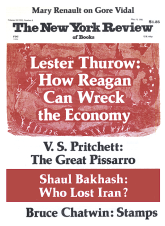In response to:
Parapsychology & Physics from the December 18, 1980 issue
To the Editors:
Mr. Martin Gardner’s reply to my letter [NYR, December 18] is couched in terms that demand a rebuttal, and with as few technical details as are necessary. His criticisms are apparently based on an account by Mr. James Randi of an evaluation by electronic circuit specialist Dr. Paul Horowitz of my early no-touch strain gauge publications and “latest protocols.” Mr. Randi was so kind as to transmit Dr. Horowitz’s criticism to me, and I quote his conclusion: “The circuit as described has a common mode rejection of only about twenty to one, whereas a 15,000:1 ratio is needed.”
As is normal practice, I measured the common mode rejection with signal generator and oscilloscope, and found it to be as high as 5,000:1 at 300 Hz even when the metal specimen is not earthed. Our normal practice for some considerable time has been to earth it and then the rejection is still higher.
Indeed, there is only “a dim understanding of how to use these sensitive devices,” but it is neither on my part nor on that of Dr. Horowitz.
Replication of no-touch strain gauge experiments in different countries has been achieved by no fewer than six qualified physical scientists whose work has been published and can be checked; but this will no doubt leave Mr. Gardner unmoved, because such people mysteriously cease to be “competent and skeptical physicists” and become “true believers.”
Mr. Gardner returns to five-year-old territory by ridiculing my accounts of the twisting together of paperclips inserted through a hole into a glass sphere, writing “Other experimenters have had no difficulty twisting paperclips and pushing them into such globes, where they intertwine to form tight scrunches, and to do it in just a few minutes.” This statement is a travesty of what was reported at the time; the sphere histories and hardware remain as a challenge to would-be ship-in-bottle craftsmen; nor is any mention made by Mr. Gardner of the few successes inside hermetically sealed glassware. I have frequently expressed doubts as to whether the spheres with holes contribute sound validation.
Mr. Gardner’s replies also contain a criticism of the filming of NBC’s documentary “Exploring the Unknown.” The protocol for the entire operation by Girard, under my supervision and close observation, would obviously preclude rotation of a previously bent rod, since the entire sequence, from smooth rolling on flat surface, through handling, to bumpy rolling, was caught on one piece of celluloid. Recalling that legal action over a previous similar claim of fraud by a European television company was narrowly avoided, I insisted that my on the spot notes be held by the company’s lawyer.
J.B. Hasted
Birkbeck College
University of London
This Issue
May 14, 1981



